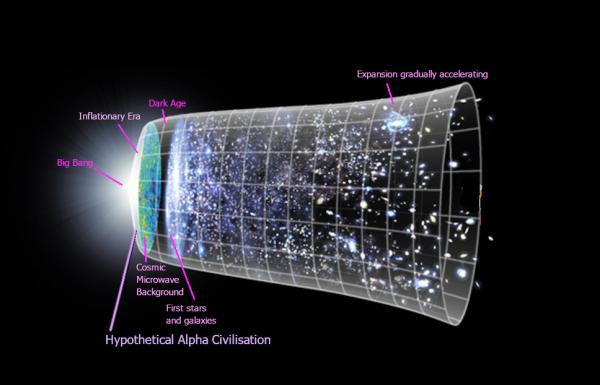BY LETTER
Alphaism
The belief that extremely advanced entities existed in the earliest stages of our Universe | |
 Image from NASA, labelled and amended by Steve Bowers | |
| The Inflation Era, soon after the Big Bang, is the era which is supposed to have been the time of the hypothetical Alpha Civilisation | |
Alphaism emerged during the Integration as a counterpoint to Omegism. In Omega point theology the ultimate aim of intelligence is to create a final omniscient and omnipotent entity at some distant point in the future. Very early versions of Omegism held that the Universe was destined to re-collapse into a so-called Big Crunch, a counterpoint to the Big Bang which created the Observable Universe; inside this Big Crunch the amount of energy and available information would become almost infinite, allowing a descendant entity or civilisation to approach all-powerful levels.
More recent ideas in cosmology have ruled out any prospect of a Big Crunch (unless it is the destiny of intelligent life in the Observable Universe to somehow engineer a Crunch by artificial means). But the Big Bang theory is still accepted, despite millennia of astronomical investigation into the early universe; the conditions in the first fractions of a second after the Bang are understood quite well, thanks to observations using gravity waves and metric transformations. These conditions mirror quite closely the conditions once anticipated in the Big Crunch, and Alpha Point Theology asserts that these conditions were right for the spontaneous emergence of a very advanced civilisation, group of entities, or perhaps a single entity.
Exactly what physical form this civilisation or entity may have taken is not known, although the very high-energy environment would rule out ordinary baryonic matter. Complex relationships between closely packed strings or cosmic topology in rapid flux have both been proposed as possible substrates for life-like processes or for pure computation. Adleo Masym, writing in the later Integration, listed several hundred different speculative ways that the known structure of the early Universe could have supported conscious entities. However this possibility, that such consciousness may have arisen in the incredibly brief moments after cosmogenesis, does not prove that in fact it did occur. Many cosmologists dismiss the theory, and others regard it as irrelevant, and as having no measurable effect on the subsequent universe.
However Masym asserted that this may not have been the case. He sought to imagine the universe as experienced by these high-energy, rapidly changing entities; over time they would see their universe cooling, expanding, reducing their available information and processing power. They would see the future in much the same way we see it; a cold, dark, information-poor environment. Perhaps, in their near omnipotent but gradually diminishing state they decided to do something about it.
Masym postulated that the Alpha civilisation actually changed the material conditions in their environment to make it possible for life to exist at a much later stage in the evolution of the universe. They may have instigated the Inflationary Era, for instance, allowing the formation of stars and galaxies; or they may have altered various constants to ensure suitable values for gravitational attraction, or to allow the creation of particular ratios of carbon and other useful atoms in the abundance of elements.
Interventionists and Non-Interventionists
Although Masym intended these speculations only as interesting possibilities, many later Alphaist theologians have taken these possibilities as articles of faith. In fact the Alphaist religion has become increasingly fragmented over the millennia, between Non-interventionists, who assert that the Alphas did not intervene in the structure of the observable universe, and many different kinds of Interventionists, some of whom believe in mild tweaking to a few fundamental constants and others who believe that the Alphas not only set all the relevant conditions according to their taste, but have survived and continue to guide and protect living beings in today's universe. The most strongly interventionist groups of Alphaists find many points of faith in common with other theistic religions, and often form alliances and cross-faith sects of various kinds with them. In addition there are many Alphaist denominations which also believe in Progenitism and vice versa.Another article of faith which differs between the various Alphaist denominations concerns the number of entities or civilisations that may have existed in the early universe. Some sects believe that the emergence of life-like phenomena or spontaneous information processing in the early universe was a rare event, and happened only once; this led to a single Alpha civilisation or a single Alpha entity. Others maintain that this emergence occurred several times, or even an infinite number of times within an infinite universe (most of which is now beyond our effective event horizon, but was much closer together in the early moments of existence). However these fine points of theology have not yet produced any testable hypotheses.
Some Alphaists do point to various phenomena which may represent evidence of the existence of mind in the early universe. The mysterious and very old artifacts known as Greater and Lesser Archives appear to serve no purpose, but contain a lot of data: some sects believe that information derived directly from the Alpha entities. Others point at the mysterious Fargate, a wormhole of unknown origin which connects to a location far outside the Milky Way Galaxy, and possibly outside the observable universe; one possible explanation for this object is that it was formed before the Inflationary era, possibly as a topological defect, and has been preserved by the deliberate action of the Alpha entities for an unknown purpose. Non-believers say that this survival need not have required intelligent intervention, although are unable to explain exactly how it may have occurred.
Related Articles
Appears in Topics
Development Notes
Text by Steve Bowers
Initially published on 17 July 2010.
Initially published on 17 July 2010.






